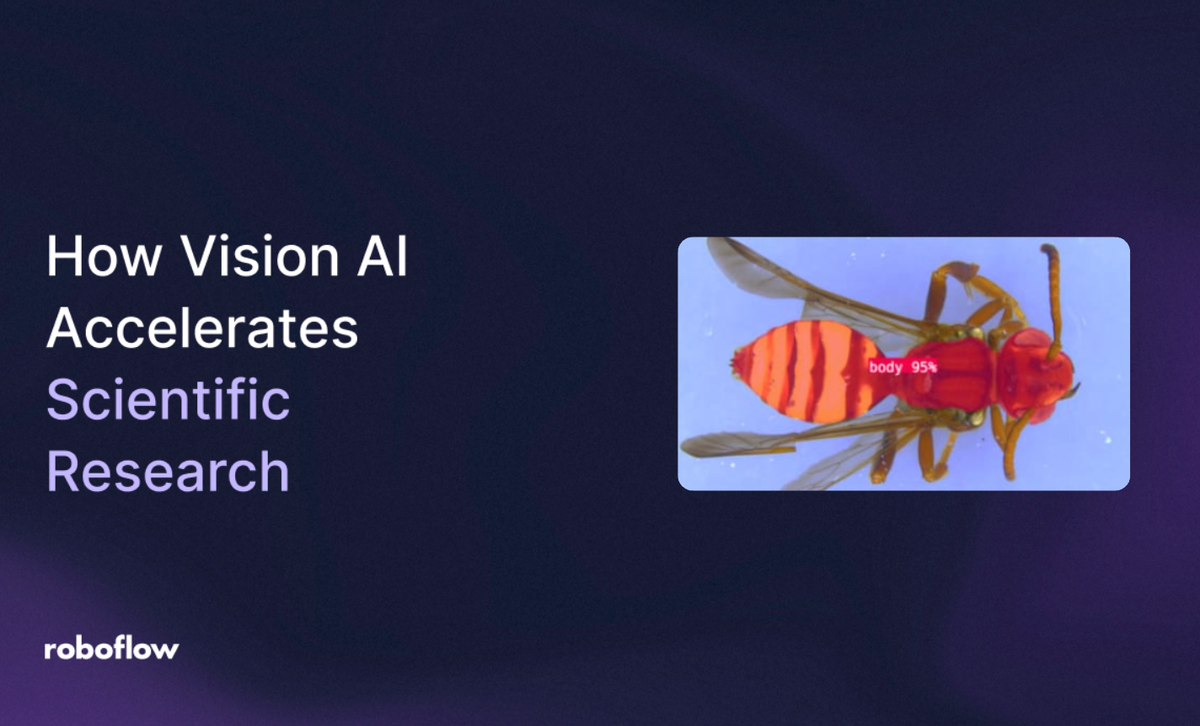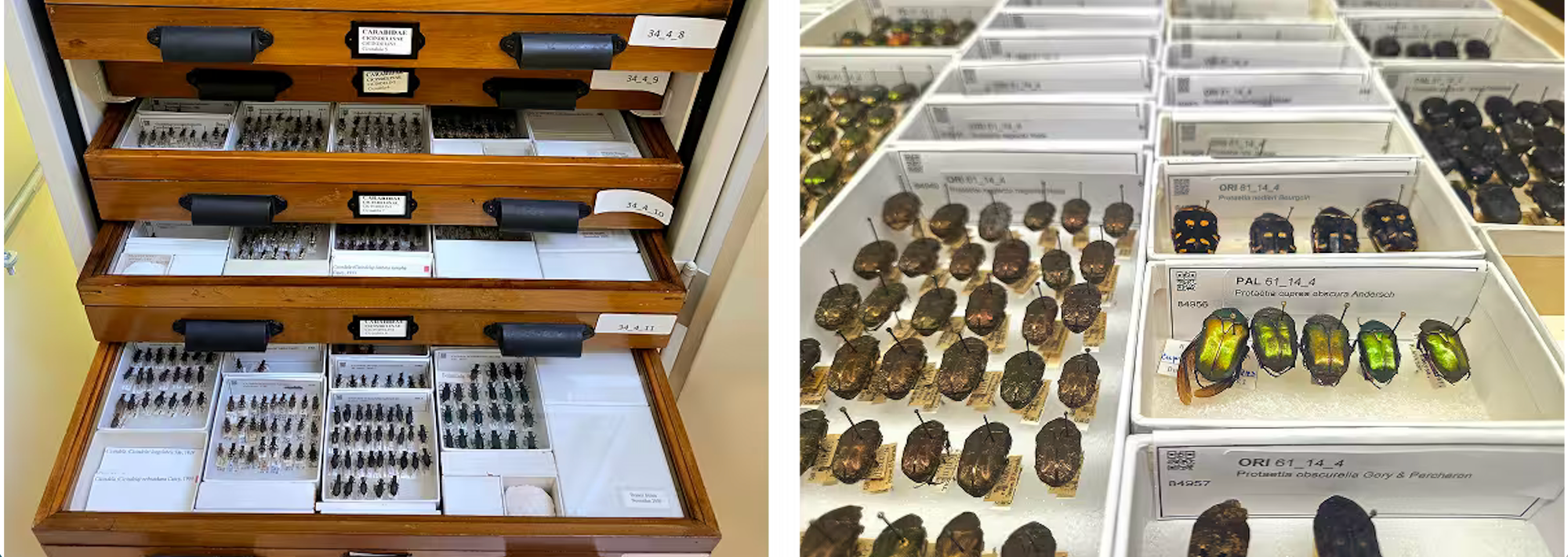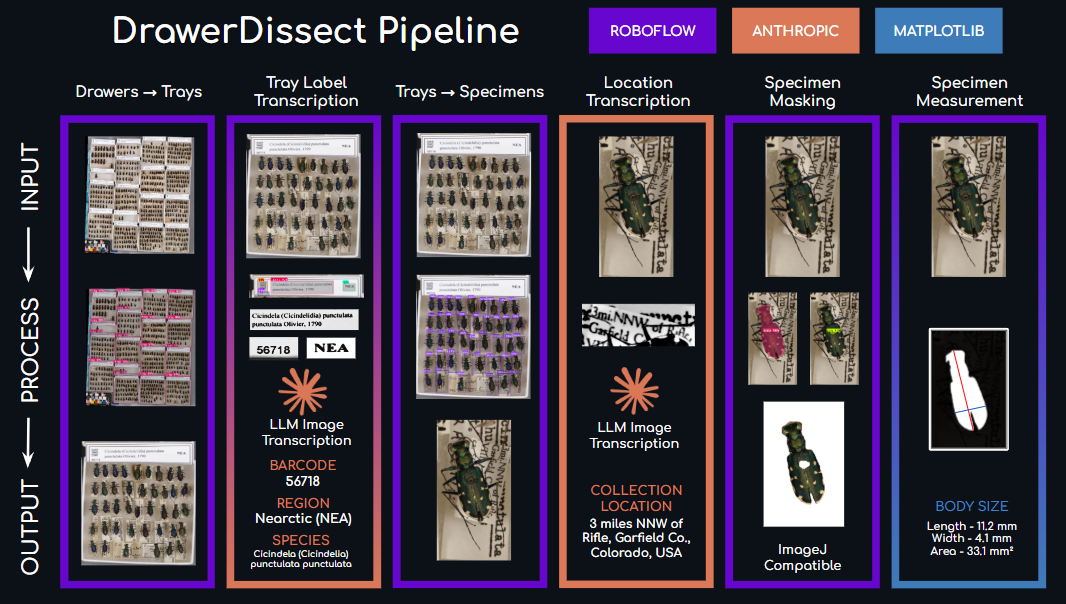
AI is accelerating how science gets done. In fields where data collection and analysis once took decades, researchers are now processing millions of samples in weeks.
At the Field Museum of Natural History in Chicago, for example, scientists digitized 13,500 insect specimens in a matter of weeks, nearly matching the 19,000 images collected over the previous 20 years. Their workflow, powered by vision AI built with Roboflow, shows how the right tools can unlock a new era of data-driven discovery.
This guide walks through how researchers in any domain can use vision AI to accelerate experiments, automate measurements, and make research more reproducible.

Why Scientific Research Needs Visual AI
Scientific progress has always been limited by one thing: time. Collecting, labeling, and analyzing experimental data is often slow, manual work.
In biology, it might mean photographing thousands of specimens. In materials science, measuring cracks under stress. In medicine, annotating microscopy slides. AI changes that dynamic. Vision AI systems can identify, segment, and measure visual data faster than any human, freeing researchers to focus on hypothesis and interpretation.
At the Field Museum, millions of pinned insect specimens sat unprocessed for decades, a priceless dataset of color, shape, and evolution. “To research the collection, we needed to better understand what was in it,” explained Dr. Bruno de Medeiros, Assistant Curator of Insects. “We needed a better way to digitize specimens and organize the data.”
That need led to DrawerDissect, an AI-powered workflow developed by Dr. Elizabeth Postema, a postdoctoral researcher at the museum.
How Vision AI Accelerates Scientific Research
AI doesn’t just automate a single task. It speeds up the entire research pipeline, from imaging to measurement to analysis. A prime example: “In the last 20 years since imaging has become a big interest of the Field Museum, we did about 19,000 images in 20 years. I was able to do 13 and a half thousand in just a few weeks time.” said Dr. Postema.

1. Automate Data Collection
The Field Museum doesn’t know the exact number of specimens they have, but Postema thinks, “...at least for pinned insects this is somewhere around 8 or 9 million, closer to 12 million if you account for all of our wet specimens, and so this massive amount of data is kind of both a blessing and a curse.”
DrawerDissect begins with a high-throughput imaging setup called GigaMacro. Instead of photographing specimens one by one, the team captures a full drawer in a single gigapixel-level image.
A custom Roboflow-trained model, Bug Finder, detects every insect in the photo and crops them into individual specimens, turning one photo into hundreds of research-ready samples.
This approach works far beyond entomology. Any field that relies on visual data, from geology to histopathology, can apply similar workflows.

2. Measure and Analyze Faster
The next step was to create Bug Masker, a segmentation model trained on thousands of insects. It outlines the body region of each specimen, excluding legs and antennae, then measures length and width automatically.
Postema validated these AI-based measurements against manual calipers, and found a near one-to-one correlation. Thousands of specimens that once required days of manual measuring can now be processed in seconds.
This same principle applies to countless forms of scientific data: cell counts, particle sizes, mineral grains, and more.

3. Integrate Metadata with Large Language Models
Every insect drawer also contains printed or handwritten labels: names, regions, collection dates, and barcodes.
DrawerDissect uses another AI step to isolate text regions and pass them to a large language model (LLM) for transcription. The model converts mixed handwriting and printed text into structured metadata automatically, outputting results in EMU-compatible spreadsheets that plug directly into the museum’s database.
The result: unified image + text datasets ready for analysis, search, and sharing.
4. Accelerate Hypothesis Testing
Once digitized, data becomes fuel for new insights. In one analysis, the Field Museum team tested Bergmann’s Rule, the biological principle that animals tend to grow larger at higher latitudes. Using data from thousands of tiger beetles, AI-assisted measurements revealed clear size-by-latitude patterns in several genera, and exceptions in others.
This scale of statistical power was simply impossible before. With AI, scientists can revisit decades-old theories, and find where they still hold true.
Build Your Own Scientific Research Vision AI Pipeline
You don’t need to be a machine learning expert to use AI for research. Postema started with no Python background and built DrawerDissect through experimentation and Roboflow’s hosted tools. Here’s a simple roadmap for applying vision AI in any scientific discipline:
1. Collect Visual Data
Capture images from experiments, microscopes, cameras, or archives. The more consistent the setup, the better the model performance.
2. Label What Matters
Use Roboflow Annotate to draw bounding boxes, polygons, or masks around your objects of interest: cells, specimens, cracks, or samples.
3. Train Your Model
Fine-tune a detector or segmenter in Roboflow Train. Models such as RF-DETR or YOLOv12 handle complex real-world data with minimal setup.
4. Deploy Anywhere
Run inference with Roboflow Deploy on cloud GPUs, local machines, or even edge devices in your lab.
5. Iterate and Improve
Add new examples, retrain, and monitor accuracy. Each iteration compounds your research efficiency.
If you can label 50 images, you can build your first scientific research AI pipeline.
Real-World Results: The Field Museum’s Transformation
The Field Museum’s journey shows what happens when AI meets scientific curiosity.
- Scale: 44 drawers (≈ 3,500 tiger beetles) digitized in 2–3 weeks.
- Throughput: ≈ 41 seconds per specimen.
- Accuracy: AI measurements match manual calipers.
- Adoption: DrawerDissect now in use at the American Museum of Natural History and the Australian National Insect Collection.
- Accessibility: All tools built with Roboflow APIs deployable by any researcher.
As Postema said, “With the computer vision models we developed in Roboflow, it’s possible to process thousands of specimens very quickly, unlocking macroevolutionary analyses at a scale that was previously not feasible.”
Try It Yourself: Scientific Research AI API
Reproduce the field museum pipeline by exploring a simplified version of the workflow on Roboflow Universe: Bug Masker API
Label a few specimen images, train a model, and deploy it to segment and measure new samples automatically. What took decades of manual cataloging can now become a weekend project!
The Future of Scientific Research AI
The next leap in scientific research AI will come from multimodal models, systems that can interpret images, text, and numerical data together.
Models like Perception Encoder, Vision Transformers, and SAM 2 are already enabling richer insights: analyzing microscopy slides alongside lab notes, or linking specimen images to field reports automatically.
As these tools become more accessible, every scientist can act as both researcher and data engineer, designing AI workflows that test ideas faster and share results more transparently.
Conclusion: AI Is the New Scientific Instrument
Vision AI isn’t replacing scientists, it’s amplifying them. The Field Museum proved that a 20-year backlog could be cleared in weeks. Other labs are using similar tools to analyze cells, map ecosystems, and track material defects in real time.
In this new era, AI is the microscope for the digital age revealing patterns too vast or subtle for the human eye alone.
Start accelerating your research today. Build your first model or dataset with Roboflow, and transform your lab.
Cite this Post
Use the following entry to cite this post in your research:
Contributing Writer. (Nov 1, 2025). Scientific Research AI: Unlocking Visual Data. Roboflow Blog: https://blog.roboflow.com/scientific-research-vision-ai/
